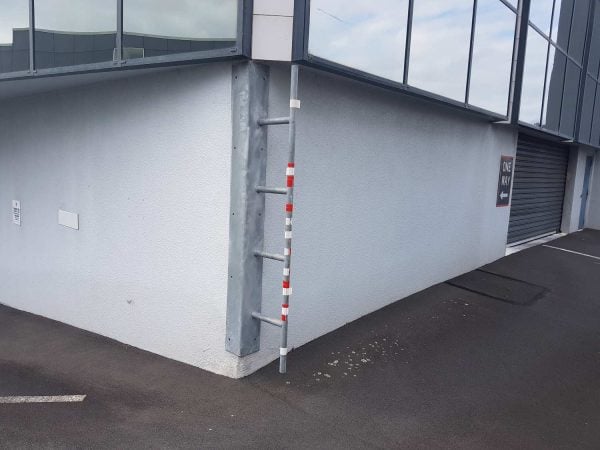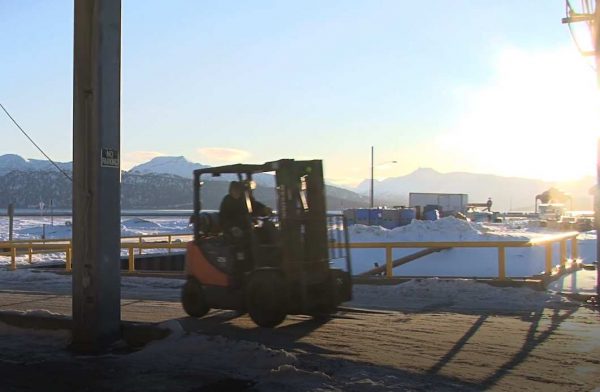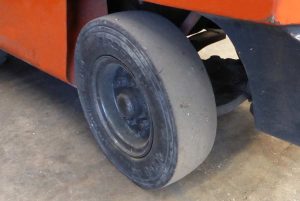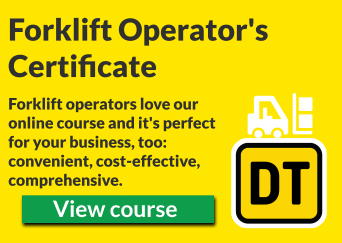The majority of forklift operators drive in a warehouse-type environment, in a yard or a mixture of both. There are a few other places where forklifts are used less frequently such as docks (for container forklifts) and farms and building sites (off-road forklifts). It’s important that the safety officer identifies the hazards and ensures that operator and pedestrian safety is taken care of.
Hazards in a yard or open space
If possible, a yard should have a gate which closes so that members of the public cannot drive or walk in uninvited.
Some operators in yards will also drive into a warehouse and when the weather is bad, this will bring wetness onto the warehouse floor from the forklift’s wheels which is then a slip hazard for pedestrians.
Uneven surfaces and potholes can cause a forklift carrying a top-heavy load to tip over. Loads should be carried at axle height when travelling on ground that’s not level. Watch for manhole covers and kerbs, and trailing cables. Spills can happen outside, especially if there are other vehicles using the area.
Overhead hazards include powerlines, awnings, balconies, signage and trees.

The weather makes it more challenging to operate a forklift:
- Wear gloves so that controls aren’t slippery when it’s raining and wear enough clothes so that you are warm in winter as your reactions are slower when you are cold and you can’t move your limbs as quickly; ice can make ramps slippery and will increase your stopping distance; fog reduces visibility
- Watch for changes in light levels when driving from inside to outside and vice versa

Other hazards are pedestrians, other forklifts and vehicles (e.g. delivery vehicles), the corners of buildings and free-standing goods.
If the operator uses the forklift on the road, care must be taken driving over kerbs. Other road users will be moving much faster than the forklift, so effective gap selection is important.
Hazards in a warehouse
Overhead hazards include pipes, cables, signage and roller doors.
Ground-based hazards include ramps, debris, slippery surfaces, trailing cables and the edges of loading docks.
Other hazards are pedestrians, other forklifts and vehicles (e.g. pallet jacks), poles and barriers, racking and free-standing goods, vapours or dust obscuring the view (e.g. steam or smoke), and poor lighting.
Hazards in a coolstore or freezer
Companies must provide specific training for operating the forklift in a coolstore. The hazards are the same as in a warehouse, but add in:
- Slippery floors – particularly if it’s a freezer. Coolstore floors can often be damp or have small patches of liquid. Forklifts used in coolstores often have minimal tread or no tread on the wheels and will not stop as quickly on these types of surfaces because they aquaplane on the water, therefore keep the speed lower

- Reduced visibility and range of movement by the driver and pedestrians if they have to wear bulky clothing to counteract the cold
- If an operator is cold, they have slower reactions and less muscle strength
- Glasses can fog if moving between a coolstore and an area with a warmer temperature
Hazards on a dock
Docks contain crush hazards for pedestrians and also the risk that a vehicle will drive over the edge.
Harsh weather can cause salt spray which impacts visibility and makes a surface more slippery. Cold weather will reduce the reaction times of the driver if the driver is cold.
Salt spray corrodes equipment much more quickly therefore a pre-start inspection is vital on every shift.
Hazards for off-road forklifts
Off-road forklifts have more ground clearance and pneumatic tyres. Operators should be aware of soft or uneven surfaces that would cause the forklift to tip over. The same weather considerations apply for open spaces, as mentioned above.
Personal hazards for forklift drivers
Forklift drivers must take care when checking their forklift, when getting off and on, and when walking around it to, for example, check some freight. Tripping on the forks is common and it can break an ankle or foot. Slipping when getting off the forklift is surprisingly easy; operators should never jump off the forklift but should climb down using three points of contact.
Drivers should keep their hands inside the frame and never grab the frame or put their hands in the forklift mechanism while moving; limbs should remain inside the frame, too. If something seems wrong with the lifting mechanism, stop, make the forklift safe (forks down, neutral, handbrake on and engine off), then report the fault to a supervisor.
In pre-start checks, drivers should be careful not to trap their fingers and not to touch areas that might be hot due to use in a previous shift. Refuelling should be done by a person who has had the appropriate training.
For some loads, drivers may need to wear extra personal protective equipment, but the minimum would be steel-capped boots and a hi-vis vest.


